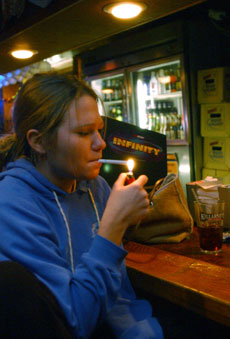Smoke-free Alliance pushes for fresher C-U

Ed Thomson
January 14, 2005
A gray haze floated above the front half of Murphy’s Pub, where the air was filled with cigarette smoke. A loud roar of the televisions blaring ESPN, laughter and chatter filled the ears of nonsmoking students, who sat in the back half of the room lounged in booths to chat while they slowly inhaled the smoke from others’ cigarettes.
“My grandpa was a frequent visitor of restaurants and bars that allowed smoking,” said Sarah Brinkmeier, sophomore in applied life studies. “He died of lung cancer a couple years ago without ever smoking a cigarette himself.”
Second-hand smoke is the third largest cause of preventable death in the United States, according to the Champaign County Tobacco Prevention Coalition. In efforts to save thousands of lives each year, cities, states and countries across the globe are adopting smoke-free ordinances to protect the health of non-smokers in public places.
The Champaign-Urbana (C-U) Smokefree Alliance would like Champaign and Urbana to adopt smoke free ordinances for all workplaces and public places, including restaurants and bars, in an attempt to prevent secondhand smoking related health issues.
“I compare smoking to target shooting,” said Scott Hays, research scientist at the Center for Prevention Research and president of the C-U SmokeFree Alliance. “Target shooters don’t practice their habit in a crowded place, because they realize their habit is fatal.”
Get The Daily Illini in your inbox!
In 1989, Illinois adopted the Clean Indoor Air Act, which was passed only a few years after the Surgeon General and EPA released reports about the dangers of secondhand smoke. The legislation required that businesses set aside a non-smoking section, regardless of their size. But there could not be stricter regulations unless they were in a city that already had its own clean air ordinances, in which case the city can modify the ordinances. Champaign and Urbana are two of about 20 cities in Illinois who have such an opportunity.
Despite the health benefits and a petition – 3, 500 signatures strong – behind the smoke-free ordinance, Champaign and Urbana city councils are hesitant to pass it.
Vic McIntosh, Champaign City Council member, said there are already restaurants in Champaign and Urbana that are smoke-free by choice.
“If restaurants allow smoking, people who don’t like it can choose not to go there,” McIntosh said. “I don’t think government has a role in legislating the choices of the business owners. They have the right to decide whether to be smoke-free just like they have the right to decide what food they serve or how they decorate.”
Hays said most Urbana City Council aldermen were supportive of the smoke-free ordinance but are reluctant to pass it without a similar ordinance being adopted by Champaign, fearing that Urbana businesses would lose smoking patrons who might take their business elsewhere.
Hays said a common misconception made by business owners is that a loss of business accompanies the implementation of a no-smoking rule. The Champaign County Tobacco Prevention Coalition contends that studies and sales tax data show a loss of business is not common, and that smoke-free policies actually tend to boost business. Proponents of the ordinance argue that only 19 percent of the C-U population actually smokes, and possible revenue losses from smokers’ business will be recovered by the gain of new customers likely to be drawn to the smoke-free environment.
“When people drink, they smoke,” said Rich Cunnington, manager of the bar Office II in Champaign. Cunnington – even though he is not a smoker – thinks the passing of a smoke-free ordinance would upset customers who expect to link the two behaviors together when they go out.
“When I come out for a drink, I’m going to have a cigarette,” said Rebecca Rock, senior in FAA, while sitting at the bar and puffing on a cigarette. “People who don’t approve of smoking in bars are already in an environment that’s not good for their health, so why are they complaining?”
Leslie Bruce, a University graduate student, spent last summer in New York, which went smoke-free in 2003, as an intern. Bruce said spending the summer in a smoke-free state was not foreign to her because she doesn’t remember a time when people could smoke in California – which has been officially
smoke-free since 1994.
“The main difference for me is to come back from the bars here and smell like an ashtray,” Bruce said. “Even non-smokers have to wash their clothes after one wear to get the stale smell out.”
Hays said a key factor of the success of a smoke-free ordinance lies in the hands of college students.
“The significant laws of the city that affected college students are alcohol-related fines, bar closing times and the presence of smoking in restaurants and bars,” Hays said.
Even though a percentage of students are not permanent residents or are not registered to vote in Champaign County, they use their disposable income to patronize Champaign-Urbana businesses for the four years of their residence.
“People have the right to be able to go out in public without sacrificing their health,” Hays said. He said the point of the ordinance is not to tell people they can’t smoke, but simply asking them to go outside to do it so everyone else in the restaurant doesn’t have to smoke with them.
For students like Brinkmeier, who have been affected by the dangers of second-hand smoke, the passing of a smoke-free ordinance may bring a change to campus life.
“I usually don’t try to think about the implication of second-hand smoke when I go out because otherwise I would be too grossed out to go out with my friends,” Brinkmeier said.






